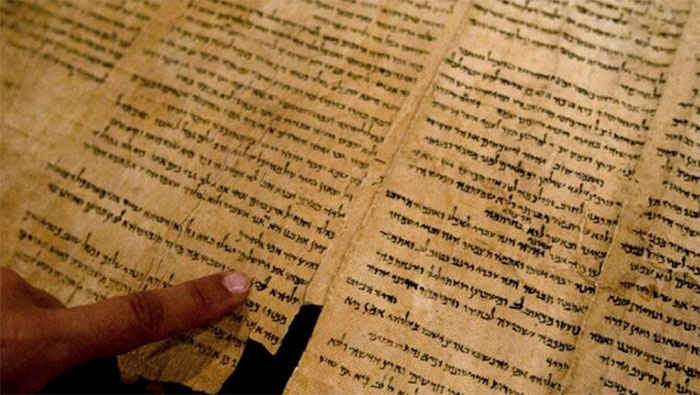Ancient DNA can reveal the mystery of the Dead Sea book
Recently, scientists analyzed small traces of ancient DNA in these fragments to piece together the story of the mysterious book.
In the 1940s, the first piece of the Dead Sea Book, dating back 2,000 years, was found in a cave near the archaeological site of Qumran on the West Bank, on the northwest coast of the Dead Sea.
Since then, subsequent pieces of the Dead Sea Book have been found scattered across 11 caves near Qumran and a few other locations on the Judean Desert. Some are also found in a collection of antique dealers.
Archaeologists now have more than 25,000 pieces of this piece, forming an ancient Literature with 1,000 ancient manuscripts. The scrolls included the first copies of the Hebrew Bible, calendar, astronomical text and community rules. Even contain information about the location of the buried treasure. Since researchers first discovered these pieces, they have been trying to put them together to understand the whole story of the mysterious but failed success.

Archaeologists now have more than 25,000 pieces of this piece, forming an ancient Literature with 1,000 ancient manuscripts.
In the past, scientists primarily did this by trying to piece together pieces like a puzzle. But because most of the pieces were made from parchment, the researchers decided to put them together with a special sign that is . ancient DNA.
In the 1990s, researchers demonstrated that they could take some ancient animal DNA from scrolls and amplify them in the laboratory using a method called polymerase chain reaction (PCR).
Senior research author Oded Rechavi, a molecular biologist at Tel Aviv University, said that now with deep sequencing technology, the technology reveals the specific sequences of the four chemical building blocks that make up DNA. of pre-existing organisms, can create traces for skin organisms used to form the Dead Sea Scrolls.
Rechavi and his team spent years analyzing ancient DNA from 26 different fragments. The problem is that getting a DNA sample without damaging the scroll is not easy. The researchers removed a bit of the dust of the Ancient Scrolls from the unrecorded side, using PCR, and they amplified the ancient DNA to detectable levels and then ran it through machines. DNA sequencing.
The researchers found that these samples contained both modern DNA as modern humans handled scrolls and fragmented ancient DNA from animals. They then compared these short sequences to the genomes of 10 animals and found that most of these fragments were made from sheep skin.
"It's amazing how much DNA can be extracted from 2000-year-old scrolls. They're not only old and polluted, they're also being treated badly for DNA ," Rechavi said.
'Because DNA is fragmented and polluted, it's often difficult to know if the DNA belongs to a different sheep than the other sheep. We have to use many different and complementary analyzes to confidently say whether the two pieces belong to each other, '' Rechavi said.
The researchers also found that the two pieces from the scrolls containing the text of Jeremiah's book were made of cowhide. Prior to these findings, one of these fragments was previously thought to match another from the Jeremiah book of sheepskin.
According to the researchers, the fact that raising cows in the Judean desert is difficult and the text found on these pieces is very different, which could mean that the pieces of cowhide are treated elsewhere and then. was taken to Qumran cave.
"We do not know exactly where the Ancient Scroll originated, but we can know, thanks to DNA analysis, that it is somewhere outside the Judean Desert. That means the Jews have opened to reading different versions of the same Bible in circulation at the time, which could also mean they were more interested in explaining text than accurate words , "Rechavi said. strong.
In addition, the researchers also discovered that some fragments believed to be from Qumran caves may have come from elsewhere.
"We don't know whether the Qumran sect represents culture elsewhere," Rechavi added.
The team now hopes to be able to study ancient DNA in more rolls, at least the samples they can sample. There are 25,000 fragments and researchers can only sample a few so there is still a lot of work to be done to identify the mysterious Dead Sea Book.
- Dead Sea ancient texts reveal 'miracles' that 2,000 years of material did not disintegrate
- Revive the book containing the mysterious mantra of the ancient Egyptians
- Reveal a part of the world's most mysterious book
- The remains of the water tank reveal the collective beheading of the ancient book
- Mysterious body of the giant in a book at the Dead Sea
- Uncover the mystery of the Maya civilization when solving an 800-year-old code to translate ancient books
- The 10 most mysterious ancient texts of all time
- Revealing the oldest Bible in the world
- Books nearly 400 years old cost more than 14 million
- Sell one of the most mysterious books in the world
- Mysterious ghost face and
- Discovered a mysterious drawing in an ancient book of 500 years old
 Discovered an ancient centipede fossil 99 million years old
Discovered an ancient centipede fossil 99 million years old Discovered bat-like dinosaurs in China
Discovered bat-like dinosaurs in China Discovered a 200-year-old bronze cannon of the coast
Discovered a 200-year-old bronze cannon of the coast Discover 305 million-year-old spider fossils
Discover 305 million-year-old spider fossils